By Scott McNutt | Photos by Charles Brooks (Exceptions Noted)
To run their systems, supply chain managers the world over require expert advice from seasoned professionals and a steady stream of polished new talent. The Department of Supply Chain Management at the University of Tennessee, Knoxville, meets their needs.
Ted Stank, Harry J. and Vivienne R. Bruce Chair of Excellence in Business in the supply chain management department at UT’s Haslam College of Business, illustrates the humble beginnings of supply chain with a speculative archetype: An ancient group of people who grew potatoes and were tired of eating them.
“They found a group that raised sheep and said, ‘Hey, we’ll trade you two wagonloads of our potatoes for a dozen of your sheep,’” Stank explains with a laugh.
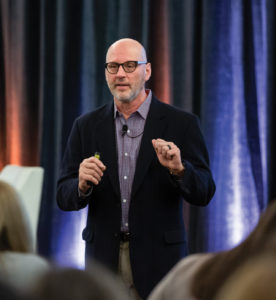
(Courtesy Photo)
This example, though fanciful, brings home the basic, transactional nature of supply chains: Someone, somewhere, has always wanted to consume something from somewhere else, and some other enterprising soul figured out how to fulfill that desire—for a price. Such simple commercial exchanges have evolved into a complex web of international interrelationships among multiple parties, including growers, extractors, transporters, manufacturers, wholesalers, retailers, deliverers and consumers. When even one piece of this complex web breaks down, the consequences—as felt during the COVID-19 pandemic—can send shocks throughout the entire system.
But more on that later.
The amount and value of goods flowing through supply chains is staggering. According to the Environmental Protection Agency, on every single day of 2015, the United States logistics industry alone moved more than 49.5 million tons of goods, worth nearly $52.7 billion.

As supply chains have burgeoned, supply-chain management experts have emerged. UT Haslam’s Department of Supply Chain Management ranked No. 3 nationally among its peer departments in the 2022 U.S. News & World Report Best Business Schools and No. 4 globally for empirical research publications in the 2020 SCM Journal List. Reflecting the increasing importance of supply chains and the growing demand for skilled leaders in this arena, the department boasts 24 faculty members (and still hiring), with more than 1,400 students, making it the largest major in the UT System.
The Hidden Complexity of a Granola Bar: Teaching Supply-Chain Management
The department uses interactive applied learning to familiarize students with the rudiments of supply-chain management, often inviting corporate partners to contribute problems for upper-level classes to tackle.
Doctoral student and engineer Annie Dohmen says she was attracted to the department by its combination of classroom practice and industry involvement, which leads to research that yields important, practical applications for the field. She sees little ivory tower academia cliche in the department.
“Ph.D. students in some departments telling you about their research will say, ‘You probably won’t understand this,’” she says. “I can talk to anyone and say, ‘You will totally understand this.’ It’s great to have that level of public understanding in your work.”
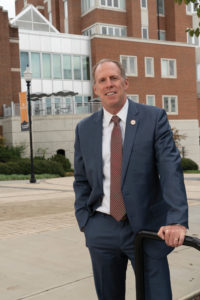
And then there’s Haslam Chair of Logistics Tom Goldsby’s granola-bar challenge. Goldsby challenges his classes to map the sources of all a granola bar’s ingredients. The grains may be grown in the U.S., but when students track the origins of the spices, sugars and fruits—not to mention the design and manufacture of the packaging—they soon find themselves on a global supply-chain hunt.
“Students can start to appreciate the complexities involved, and then we’ll talk about the efforts that go into getting that product from an assembly line into my hands,” Goldsby says.
The assignment delivers an additional “Aha!” moment. Goldsby’s students sometimes can present their results to supply-chain leaders at the granola-bar company. Each time they do, the company representatives learn something about their supply chain that they didn’t know. Through such teaching moments, the department prepares its students to step into leadership roles at major companies.
“We understand these businesses’ needs and tailor what we do in our classrooms and our research to fulfill those needs,” Stank says. “We’re a talent development and knowledge development partner for those stakeholders. I think that’s unique in an academic department.”
To further strengthen the bonds between its faculty and students and industry leaders, the department has established two associated organizations.
The Global Supply Chain Institute (GSCI), founded in 2012, is a global network connecting the boldest supply-chain professionals and industry leaders with the brightest emerging talent. Through GSCI, industry leaders have a community in which they can share ideas and best practices and solve critical issues in real time, shaping the future of supply-chain management.
Founded in 2019, the Advanced Supply Chain Collaborative (ASCC) works as a collegial think tank, engaging industry experts with UT faculty to explore the latest concepts in supply-chain management to build supply chains of the future. ASCC is growing a coalition of business practitioners and scholars focused on understanding how companies can leverage advanced innovations. In 2019-2020, ASCC members’ research included areas such as workforce transformation, supply-chain agility, data strategies and the return on investment of blockchain.
This year, Supply Chain Forum Premium Partner and ASCC company partner Bush Brothers and Company confronted supply-chain problems associated with the pandemic. The company’s project with the ASCC helped overcome them.
Putting the Dominoes Back in the Line: Supporting Shaky Supply Chains
When COVID-19 hit and the U.S. went into lockdown, people staying home were coping with tremendous uncertainty. In addition to buying up cleaning supplies and toilet paper, consumers craved comfort foods.
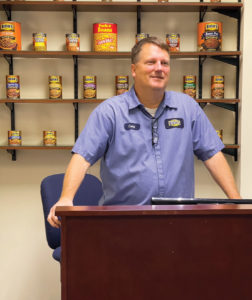
“Bush Beans certainly fits that bill,” Goldsby says. “Bush faced a sudden demand situation, and they were finding capacity wherever they could.”
With supply chains disrupted, however, obtaining the materials the bean company needed proved difficult. In trying to meet the demand surge while battling emerging gaps in its supply chain, Bush threw everything, including the kitchen sink, at the problem, Dohmen says. However, that approach meant that Bush didn’t know what worked and what didn’t. From long experience, Craig Elonen, Bush’s senior vice president of manufacturing and logistics, suspected some measures were more effective than others, but he couldn’t verify it.
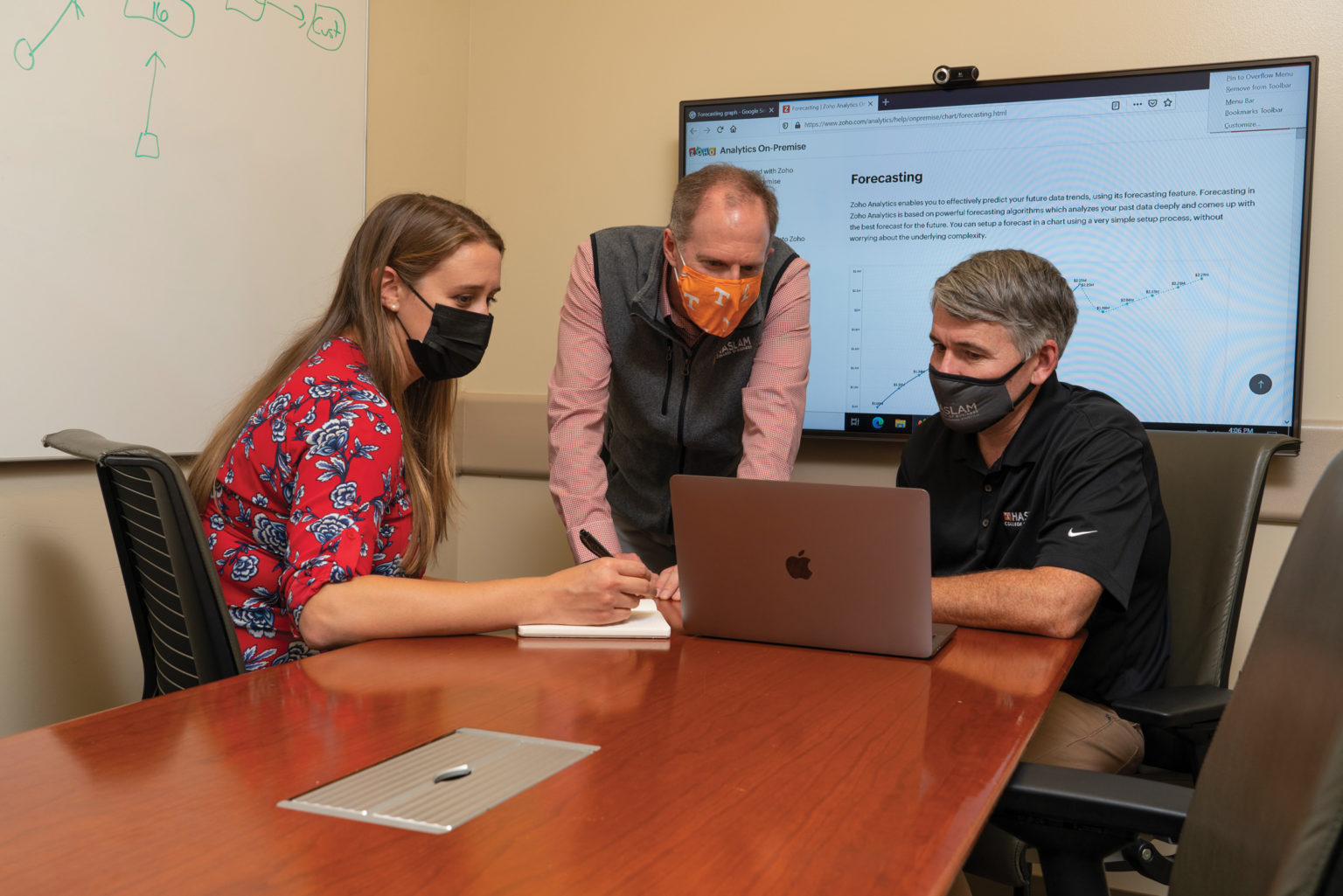
Before the pandemic struck, a team of Haslam’s best, including Stank, Goldsby, doctoral candidate Dohmen and Lance Saunders (Knoxville ’01, ’03), Stewart Bartley Family Research Fellow, had been discussing with Elonen how to identify potential areas for improvement in Bush’s processes using computer simulations. They used the simulations to examine what happened to Bush’s supply chain during the pandemic’s disruptions.
Saunders explains their work by likening supply chains to a line of dominoes. When the dominoes are all in place and the first one is pushed, they all fall in line.
“What happens when you take a domino out?” Saunders asks. “The line stops. In supply chain, we have mitigations that can fix the problem with one domino. When COVID hit, eight or 10 dominoes at a time were coming out of Bush’s supply line. Bush started putting in dominoes everywhere to try to fix it, but you don’t really know which one is making the difference. What we were able to do through the simulation was put those dominoes back in the chain one at a time to understand which one had the biggest impact.”
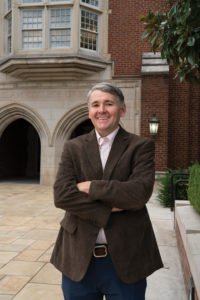
This provided Elonen quantitative evidence to support his hunches, enabling him to validate decisions he had made.
The result, according to Elonen, was that Bush Brothers could continue to meet the elevated demand and present its brand to a much larger swath of consumers.
“The volumetric year we had was incredible,” he says.
He adds that the demand hasn’t gone away, so Bush is working to systematically build back inventory across all its distribution channels.
“Bush knows what they’re going to do next time,” Dohmen says. “We’re hoping that the learnings we have can be applied to similar industries.”
The Ongoing Academia-Industry Connection
The supply-chain management department regularly brings together faculty, students and industry leaders through its various initiatives to meet the challenges facing supply chains everywhere. Many of those industry leaders also happen to be program alumni. Barbara Melvin, South Carolina Ports Authority chief operations officer, earned her executive MBA in global supply-chain management from the program in 2018. Melvin is in line to become CEO when another alumnus, Jim Newsome (Knoxville ’76, ’77), retires next year.
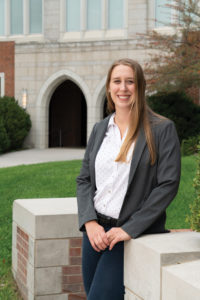
“If you’re tapping into the UT network and Global Supply Chain Institute partners, you’re linked to everybody that’s relevant within our industry, which is a true benefit of the institute and being an alum of UT,” Melvin says.
Other former students include Dave Clark (Knoxville, ’99), Amazon’s CEO Worldwide Consumer; Nancy Nix (Knoxville, ’01), executive director emeritus at AWESOMELeaders.org; Donald Frieson (Knoxville, ’90), Lowe’s executive vice president of supply chain; and Amanda Tolhurst (Knoxville, ’00), Converse’s chief operations officer. While the department teaches traditional students, its offerings include programs that appeal to executives like Melvin, professionals pursuing careers in other industries like Dohmen and people from many other walks of life.
“When we say ‘students,’ we mean that in multiple ways,” Stank says. “We teach everything, including undergraduate students, traditional MBA students, an online MS program, traditional MS program, executive MBA programs, Saturday MBA programs and senior executives. We need a group of people who are solidly grounded in industry and understand practical issues, and are highly expert at science, so that we can apply that science to real-world problems and separate truth from hype.”

Always in high demand, UT Knoxville’s supply-chain management department’s expertise has lately been in constant demand. In the months leading up to the holidays, as the nation grew more alarmed at consumer-good shortages and shipping delays, faculty members were fielding daily media inquiries and advising government representatives.
Throughout this time, the department has continued to advance the academic discipline and the business field through classroom instruction, forums, presentations, corporate partnerships, community outreach and government policy commentary. As 2022 dawns and someone, somewhere, wants a good or service from somewhere else in ever faster and more sophisticated ways, the department will continue to be a supplier of relevant, applicable research and highly skilled new leaders for the supply chain industry.
And that’s good news on a global scale.



